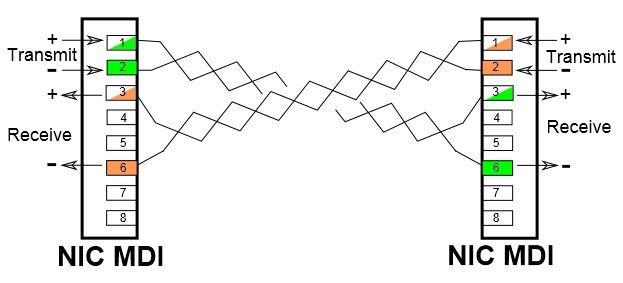Types of Ethernet cables – straight-through and crossover
Ethernet cables can come in two forms when it comes to wiring:
1. Straight-through cable
This cable type has identical wiring on both ends (pin 1 on one end of the cable is connected to pin 1 at the other end of the cable, pin 2 is connected to pin 2 etc.):
This type of cable is used to connect the following devices:
- computer to hub
- computer to switch
- router to hub
- router to switch
Computers and routers use wires 1 and 2 to transmit data and wires 3 and 6 to receive data. Hubs and switches use wires 1 and 2 to receive data and wires 3 and 6 to send data. That is why, if you want to connect two computers together, you will need a crossover cable.
2. Crossover cable
With the crossover cable, the wire pairs are swapped, which means that different pins are connected together – pin 1 on one end of the cable is connected to pin 3 on the other end, pin 2 on one end is connected to pin 6 on the other end (Photo credit: Wikipedia):
This type of cable is used when you need to connect two devices that use same wires to send and receive data. For example, consider connecting two computers together. If you use straight-through cable, with identical wiring in both ends, both computers will use wires 1 and 2 to send data. If computer A sends some packets to computer B, computer A will send that data using wires 1 and 2. That will cause a problem because computers expect packets to be received on wires 3 and 6, and your network will not work properly. This is why you need to use a crossover cable for such connections.


Comments
Post a Comment